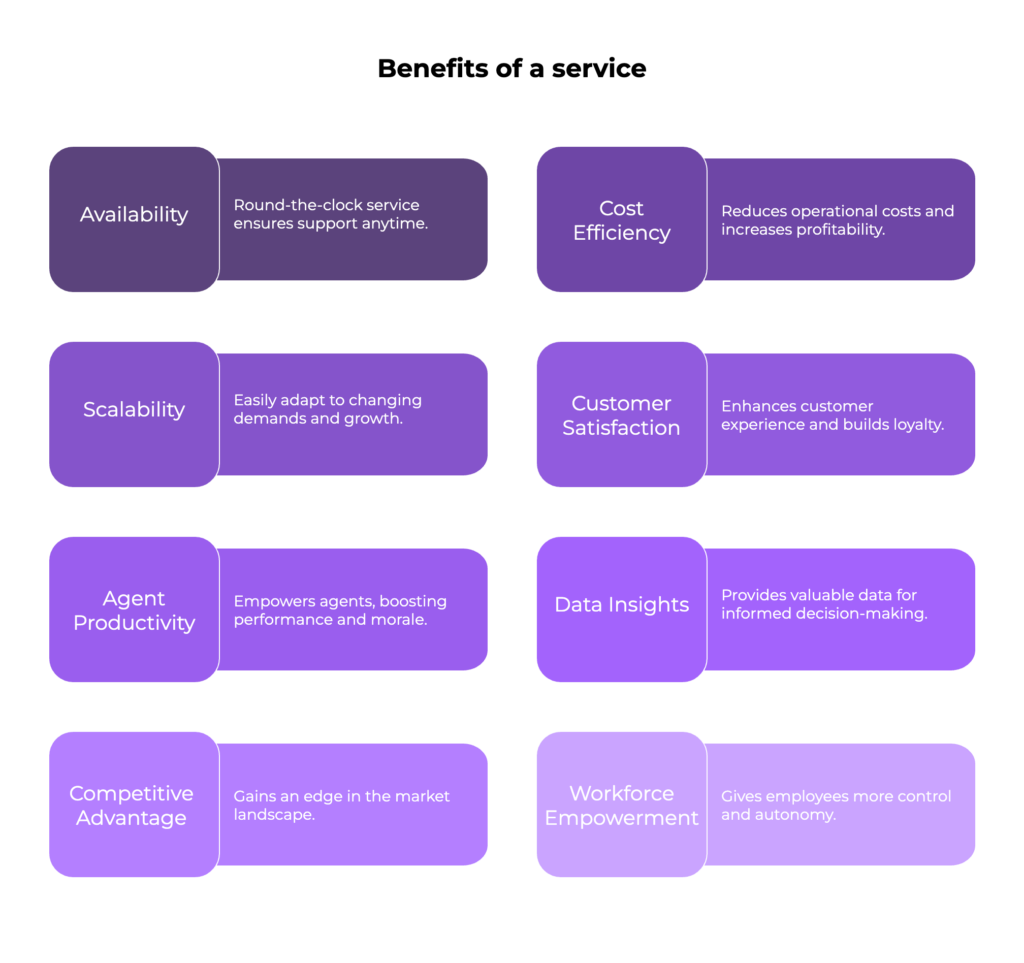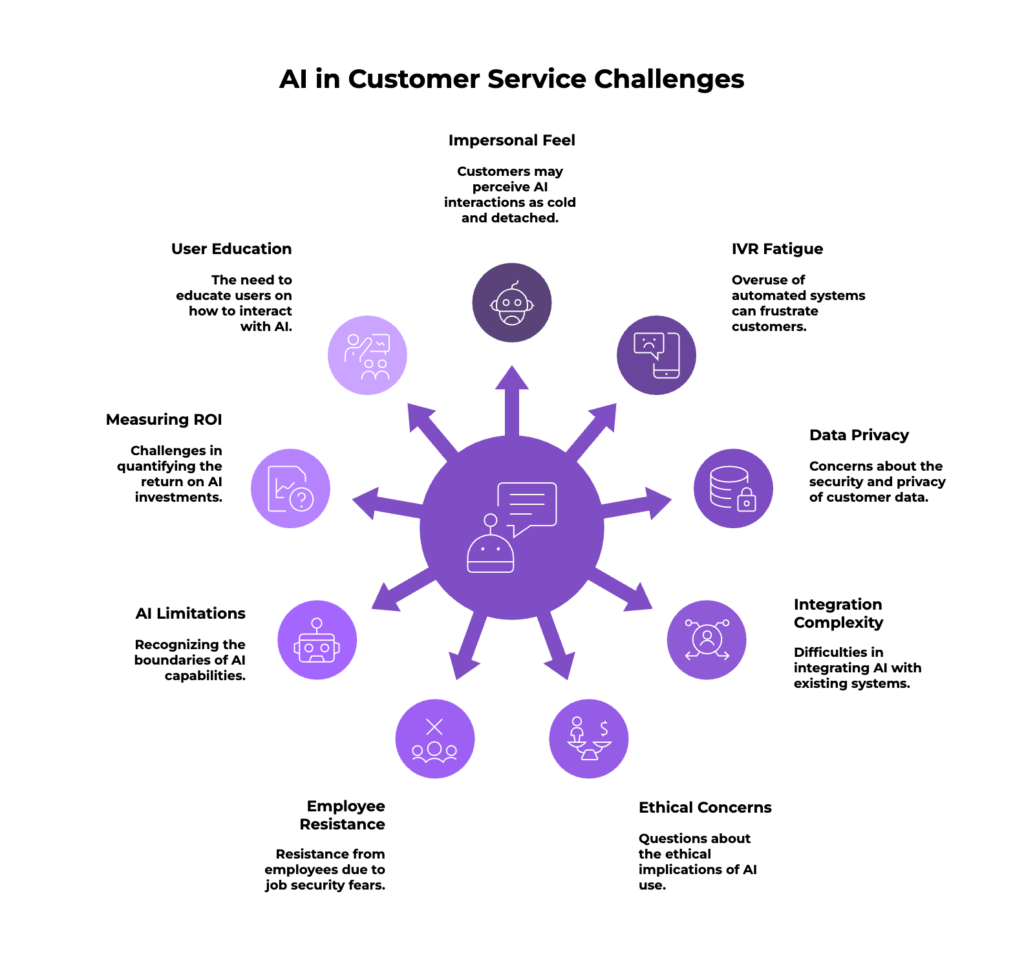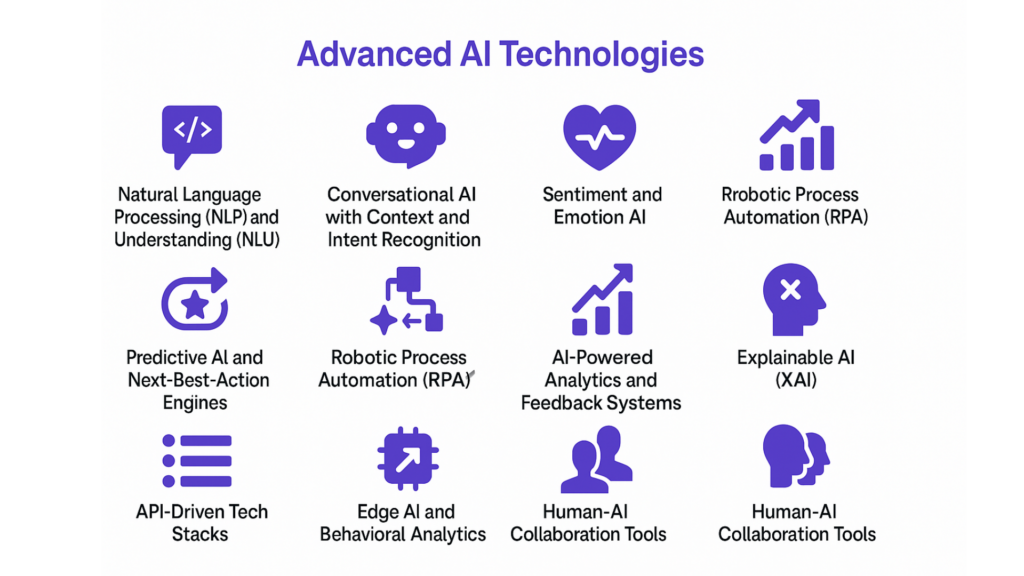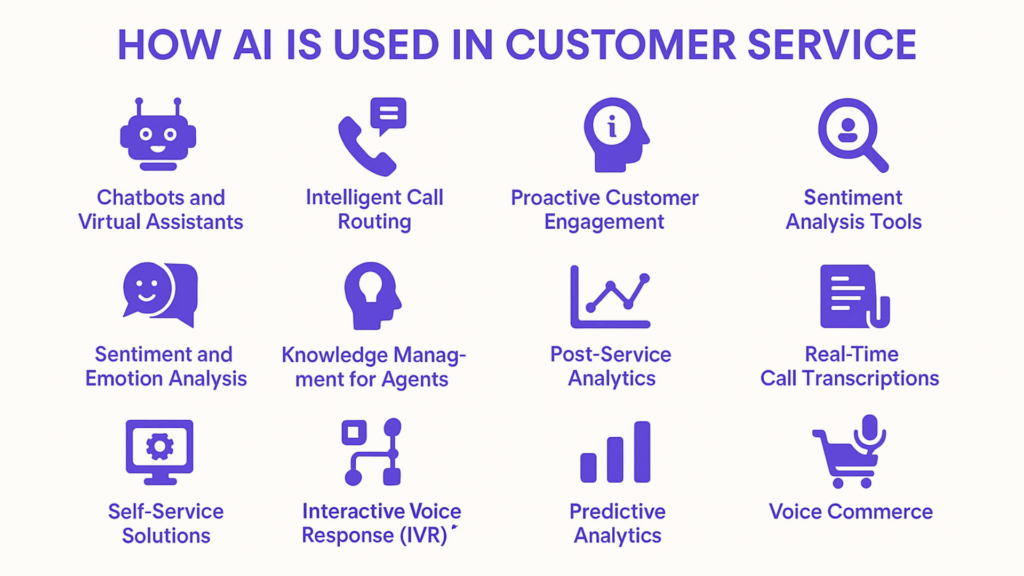Discover how AI is transforming customer service, its use cases, benefits, best practices, and real-world insights for CX leaders and innovators.
Imagine calling customer service in 1995.
You’d wait 20 minutes on hold, listen to the same elevator music on repeat, only to be transferred three times before reaching someone who couldn’t access your account history.
Now, imagine calling today. An AI assistant greets you by name, knows why you’re calling before you explain, and resolves your issue in under two minutes.
This isn’t science fiction. This is Wednesday.
In this blog, let’s dive into the role of AI in customer service, elaborating on its use cases, benefits, challenges, and future trends. We also explore real-world examples, best practices for implementing AI, and the critical interplay between human agents and AI. Whether you are an executive, customer service leader, or tech enthusiast, this guide offers detailed, actionable insights on navigating the AI customer service revolution.
What is AI in Customer Service?
Artificial intelligence (AI) is technology that enables computers and machines to simulate human learning, comprehension, problem solving, decision making, creativity and autonomy. [IBM, Artificial Intelligence]
In customer service, AI mimics human cognitive functions to provide assistance, automate routine tasks, analyze consumer behavior, and optimize communication channels.
AI’s uniqueness lies in its ability to continuously improve through machine learning, a subfield that enables systems to learn from data and get better without explicit programming. This includes creating neural networks modeled loosely after the human brain to recognize intent, sentiment, and context in customer inquiries.
The integration of AI into customer service revolutionizes how customers interact with businesses. AI-powered solutions add new digital channels such as chatbots and virtual assistants that communicate using language processed by Natural Language Processing (NLP) and Natural Language Understanding (NLU).
These systems are capable of managing vast volumes of inquiries 24/7, transforming traditional customer service into a proactive, data-driven function.
AI is moving beyond simple augmentation. Forward-thinking companies are now achieving complete automation of customer support workflows, eliminating the need for human agents in routine interactions. Trilogy’s implementation demonstrates how organizations can fully automate their support operations while redirecting human talent toward more meaningful, strategic initiatives.
AI handles repetitive, high-volume tasks; allowing human agents to focus on complex, empathetic, and value-driven interactions.
But this isn’t just about machines talking to people. It’s about reshaping the entire foundation of service. It ensures touchpoint becomes smarter, more contextual, and infinitely scalable. So how exactly is AI being put to work?
How AI is Used in Customer Service
You don’t need to look far to find AI in action; it’s handling your refund request, tracking your parcel, even predicting your next problem before it arises. From chatbots to call routing, AI is everywhere, quietly rewriting the rules of engagement.
AI is applied at various touchpoints within customer service to increase efficiency and customer satisfaction:
Chatbots and Virtual Assistants:
Handle routine inquiries like billing, order tracking, refunds, appointment scheduling, and FAQs. Chatbots use NLP for conversational engagement, learning from interactions to improve responses over time.
Intelligent Call Routing:
AI analyzes caller information and intent to direct the inquiry to the best-suited agent. For instance, routing can consider language preferences, inquiry type, sentiment, and customer value, improving both resolution times and satisfaction.
Sentiment and Emotion Analysis:
AI detects emotions from voice tone or written text (e.g., frustration or urgency) to prioritize cases and tailor agent responses for empathy.
Self-Service Solutions:
AI powers interactive voice response (IVR) alternatives through natural conversations, encouraging customers to resolve issues independently, thus deflecting calls.
Proactive Customer Engagement:
AI anticipates customer needs using data insights, sending payment reminders or alerts about unusual account activity before the customer reaches out.
Knowledge Management for Agents:
AI aids agents by automatically surfacing relevant information, FAQs, or support scripts in real time during calls, enabling faster, more accurate assistance.
Post-Service Analytics:
AI analyzes customer feedback, interactions, and social media to identify trends for continuous improvement.
A McKinsey analysis of an Asian bank’s digital transformation showed AI implementations doubled the use of self-service channels, lowered service interactions by 4050%, and reduced cost-to-serve by over 20%; showcasing AI’s scalability and impact on efficiency and experience.
Interactive Voice Response (IVR) Enhancement
Conversational AI improves traditional IVR systems by understanding complex requests, recognizing multiple languages, and smoothly transferring calls to agents if needed.
Sentiment Analysis Tools: Gauge customer mood and escalate issues proactively to prevent churn.
Case Management and Routing
AI systems automatically generate tickets from social media posts or chats, categorize them, and route to appropriate human or bot support.
Real Time Call Transcriptions
Assist quality assurance, training, and secure handling of complex cases.
Predictive Analytics
AI forecasts customer behaviors such as likelihood to churn, need for service, or receptiveness to upselling.
Voice Commerce
AI-powered voice assistants allow customers to shop or manage services using natural speech, enhancing convenience and engagement.
The widespread adoption of these tools reflects the acceleration of AI’s role in transforming routine contact center operations into strategic customer engagement hubs.
As these touchpoints become more intelligent and interconnected, we’re moving from reactive support to predictive service. But beyond function lies impact.
What tangible business value does this transformation actually deliver?
Key Benefits of AI in Customer Service

When done right, AI doesn’t just streamline operations—it transforms them. While many organizations use AI to elevate their teams, we’re seeing pioneering companies take it further. Some, like Klarna and Trilogy, have successfully removed humans from their support processes, achieving dramatic cost reductions while redirecting their talent to higher-value work. The question isn’t whether AI can replace humans—it’s whether your organization is ready to capture that advantage.
Let’s look at how AI turns everyday support into a competitive advantage.
24/7 Availability
AI-powered chatbots and virtual agents provide round the clock service, meeting customer demands across global time zones; a necessity in today’s digital marketplace.
Cost Efficiency
Automating routine inquiries reduces dependency on live agents, lowers call center costs, and optimizes resource allocation. Gartner estimates self-service channels cost about $0.10 per contact compared to $8.01 for live agent calls.
Scalability
AI enables businesses to manage spikes in customer interactions without loss of quality or requiring rapid agent hiring.
Improved Customer Satisfaction
Instant responses and proactive engagement increase customer loyalty and retention.
Increased Agent Productivity and Satisfaction
By offloading repetitive tasks, agents focus on complex issues, resulting in less burnout and higher morale, a critical issue as call centers experience high turnover due to repetitive work.
Data Driven Insights
AI analyzes interaction data to identify common issues, enabling continuous service improvements and personalized offerings.
Competitive Advantage
Businesses integrating AI outperform competitors through innovation and enhanced customer experience. Spending on AI is projected to exceed $125 billion by 2025.
Workforce Empowerment
AI chatbots which are deployable in under a week, have democratized AI benefits, making them accessible to enterprises of all sizes, including community banks and credit unions.
These benefits collectively improve business agility and customer lifetime value (CLV), vital in fiercely competitive markets.
Before diving into AI adoption, it’s important to understand the potential challenges that can impact your results and customer trust.
Of course, no powerful tool comes without trade-offs. And as companies rush to adopt AI, they must also confront its friction points—technical, ethical, and human. Let’s unpack the risks and realities.
Challenges and Considerations When Using AI in Customer Service

Despite compelling advantages, AI adoption carries challenges:
- Impersonal Feel: Some customers, particularly older demographics, find AI interactions cold or frustrating. Complex or sensitive issues often require human intervention.
- IVR Fatigue: Legacy voice menus remain unpopular, and poorly designed AI chatbots can frustrate customers if unable to understand unique queries or context.
- Data Privacy and Security: Handling sensitive customer data requires strict compliance with regulations like GDPR and HIPAA, demanding transparency in AI use.
- Integration Complexity and Costs: Connecting AI systems to legacy platforms, CRMs, and omnichannel data sources can be technically challenging and resource-intensive.
- Ethical Concerns: Addressing AI bias, fairness, and transparency is critical to maintaining customer trust.
- Employee Resistance: Agents may fear job displacement or increased surveillance through AI-driven performance analytics.
- AI Limitations: Inability to understand nuance or context fully, language barriers, slang, and cultural differences can limit AI efficacy.
- Measuring ROI: Quantifying the bottomline impact of AI investments and justifying expenditures remains a concern, especially for smaller businesses.
- User Education: Customers and staff need guidance to effectively use AI-driven tools and set realistic expectations.
Awareness and proactive management of these issues are essential to maximizing AI’s transformative potential with minimal disruption.
Yet, even with its flaws, AI keeps evolving—and so do the solutions. The next wave of AI isn’t just smarter; it’s more contextual, empathetic, and explainable. Here’s what’s pushing the frontier forward.
Advanced AI Technologies Enhancing Customer Service

Beyond fundamental applications, sophisticated AI technologies are shaping next-gen customer service:
Natural Language Processing (NLP) and Understanding (NLU)
These enable nuanced comprehension of language, slang, dialects, and multiturn conversations, essential for smooth dialogue floweven allowing switching languages mid-conversation.
Conversational AI with Context and Intent Recognition
Advanced bots maintain conversation context, handle multiple topics, and manage transitions between bot and human agents seamlessly.
Sentiment and Emotion AI
Analyze voice and text to detect emotions with enough accuracy to influence agent coaching and intervention in real time.
Predictive AI and Next-Best-Action Engines
These recommend personalized offers, services, or issue resolutions based on a customer’s profile and past behavior.
Robotic Process Automation (RPA)
Automates backoffice functions such as data entry, form filling, or refund processing triggered during customer interactions.
API-Driven Tech Stacks
AI systems are increasingly modular and interoperable, integrating CRM, telephony, cloud services, and data lakes to provide holistic support ecosystems.
Edge AI and Behavioral Analytics
Emerging capabilities allow insights to be processed closer to customer devices, enabling real-time personalization and reducing latency.
Explainable AI (XAI)
Helps humans understand AI decisions to build trust and meet compliance requirements.
Human-AI Collaboration Tools
AI augments agents by predicting responses, performance coaching, compliance checks, and surfacing relevant knowledge during live interactions.
These technologies collectively drive customer service maturity across a five-level spectrum from manual operations to fully personalized, digitally engaged service models.
These aren’t just buzzwords; they’re the new building blocks of customer experience. But all this sophistication would be meaningless if it didn’t translate to something customers actually feel: personalization, empathy, and ease. Let’s explore how AI makes that real.
How AI Improves Customer Experience and Personalization
What if your support team could remember every past conversation, predict what you want, and speak your language—literally and figuratively? That’s what AI makes possible: a level of personalization that feels almost… human.
The heart of AI’s value in customer service lies in enhancing the customer experience (CX) through:
- Hyper-Personalization: AI analyzes extensive customer data across CRM, social media, purchase history, and browsing patterns to customize every interaction. For example, AI can suggest products based on predicted buying intent and recommend content or offers likely to resonate.
- Proactive Engagement: AI anticipates needs, sending timely alerts about payments, order status, or potential issues before customers seek help, minimizing frustration.
- Seamless Multi-Channel Experience: AI orchestrates interactions across chat, email, voice, social media, and even in-person channels, ensuring customers experience consistent and coherent conversations regardless of touchpoint.
- Faster Resolution: Intelligent routing and agent assist tools reduce wait times and first contact resolution improves by up to 20% with AI
- Emotional Intelligence in AI: By analyzing tone and sentiment, AI tailors responses and prioritizes urgent or sensitive cases, improving empathy even through automated channels.
- Enhanced Self-Service: AI reduces friction by empowering customers to solve simple problems autonomously while escalating complex issues promptly.
- Continuous Learning: AI models improve with every interaction, adapting to customer preferences and evolving language to enhance future service quality.
By embedding these capabilities, organizations meet rising customer expectations where 71% of consumers demand personalized interactions, and 76% express frustration when these are lacking.
But how do companies go from concept to capability? Let’s look at how to bring AI into service without losing the human touch.
Implementing AI in Customer Service: Best Practices
Adopting AI is less about flipping a switch and more like planting a garden. It takes vision, planning, and a lot of nurturing. The good news? You don’t have to do it all at once.
Successful AI adoption requires a strategic roadmap:
1. Align AI Initiatives with Business Goals
Define key pain points (e.g., long wait times, high costs) and desired outcomes like reduced call volume, improved CSAT scores, or higher agent retention.
2. Start Small with Pilot Projects
Deploy chatbots for routine inquiries as a low-risk introduction to AI capabilities, generating early wins to build momentum.
3. Secure Stakeholder Buy-In:
Engage executives, agents, IT, and customers to address concerns and highlight AI’s augmentation role, not replacement.
4. Partner with the Right Vendors
Choose AI solutions with robust NLP, flexible integration capabilities, and proven performance metrics.
5. Invest in Change Management
Train employees, designate AI champions, and develop processes to incorporate AI insights into workflows seamlessly.
6. Ensure Technical Readiness
Leverage cloud infrastructure, API-driven platforms, and maintain secure, high-performance networks for real-time data and communication flows.
7. Iterate Based on Feedback
Collect input from customers and agents, analyze AI performance data regularly, and refine AI models and processes.
8. Integrate Human and AI Seamlessly
Allow bots to escalate to live agents with full conversation context, and augment agents with AI-based insights and compliance checks.
9. Measure Success with KPIs
Monitor CSAT, first contact resolution, cost per contact, bot containment rates, and agent satisfaction to quantify AI impact.
10. Plan for Scalability
Prepare for growth in interaction volume, multichannel complexity, and evolving AI capabilities.
The goal is to create a customer service ecosystem where AI and human agents collaborate effectively to deliver personalized, efficient, and empathetic service at scale.
Measuring the Effectiveness of AI in Customer Service

Quantifying AI’s impact relies on comprehensive metrics:
- Customer Metrics: CSAT (Customer Satisfaction), NPS (Net Promoter Score), customer effort score, first contact resolution, average resolution time, and repeat contact rates.
- Operational Metrics: Call volume deflection, bot containment rates, average handle time, cost per interaction, escalation rates from bots to agents, and revenue per customer.
- Agent Metrics: Productivity improvements, reduction in repetitive task time, employee satisfaction, attrition rates, and training efficiency.
- AI Specific KPIs: Intent recognition accuracy, sentiment prediction accuracy, conversation containment effectiveness, chatbot session success rate, and AI-related errors or failures.
- Business Impact: ROI calculations incorporating cost savings, increased upsell/crosssell from AI-driven recommendations, and reduced churn.
- Real time analytics platforms and AI dashboards enable continuous monitoring and actionable insights that inform ongoing AI optimization.
For example, firms leveraging Sprinklr Modern Care can handle billions of AI model predictions daily to benchmark and improve service across multiple languages and verticals.
See Kayako’s Help Center Analytics
The Future of AI in Customer Service
AI isn’t standing still. It’s writing its own playbook—with every prompt, every conversation, every click. The future won’t be human vs machine—it’ll be human + machine, working in sync.
Looking forward, AI will deepen its integration into customer service ecosystems with:
- Generative AI and Large Language Models (LLMs): Enabling highly natural, humanlike conversations and proactive, creative problem solving.
- Edge AI Integration: Processing data closer to users for instant personalized responses without latency.
- XAI (Explainable AI): Building trust by clarifying AI decision-making processes, crucial for compliance and customer confidence.
- Increased Human-AI Collaboration: AI will continue to augment rather than replace agents, providing nuanced support, mentorship, and training.
- Emotional AI: Better sensing and responding to human emotions improves empathetic engagement.
- Omnichannel Evolution: AI will unify experiences seamlessly across voice, text, video, augmented reality, and even IoT devices.
- Voice Commerce Growth: Natural language voice interactions will become a mainstream channel for commerce and support.
- Holistic Customer Engagement: AI will integrate marketing, sales, and service insights in real time to offer hypercontextualized engagement.
- AI Ethics and Regulation: Heightened focus on responsible AI adoption, fairness, transparency, and bias mitigation will govern practice standards.
As AI matures, customer service will become more personalized, anticipatory, and efficient, fundamentally transforming the consumer business relationship.
And that future is closer than you think. Those who embrace it now won’t just serve customers better—they’ll redefine what great service even means.
How AI is Saving Customer Service
Call centers were on the brink – understaffed, overburdened, and under pressure. Then came AI, not as a band-aid, but a lifeline. In a crisis, it became the glue holding customer relationships together.
The pandemic accelerated the demand for contactless, remote, and instant customer service solutions.
AI answered this call by providing always on support channels, thus expanding customer service hours beyond human agent availability and reducing wait times dramatically
For example, AI-powered chatbot can be integrated rapidly into websites and handle complex FAQ capabilities to assist customers independently or assist agents with information retrieval. Organizations that implemented AI saw:
- Massive reductions in call volume: AI handles common queries, freeing human agents to handle complex issues.
- Improved customer and employee experiences: Employees face less repetitive stress, lowering attrition, while customers get faster resolutions and personalized service.
- Cost savings: AI dramatically reduces service costs by automating self-service and preventing unnecessary human interactions.
- Proactive service: AI analyzes data to anticipate issues and engage customers before they encounter problems.
- Competitive necessity: As AI tools become table stakes, early adopters enhance their market positioning and customer loyalty.
Businesses, from major banks to community credit unions, are witnessing transformative benefits using scalable, affordable AI solutions. The result is a new customer service paradigm where AI complements human agents, delivering continuous, efficient, and empathetic service worldwide.
The lesson? AI isn’t a future trend – it’s the present tense. And the businesses using it right are already reaping long-term loyalty and resilience.
AI-Powered Automation: Elevating Agent Performance
While the spotlight often falls on AI chatbots, the real magic is backstage—where AI quietly empowers human agents to be faster, smarter, and more focused.
AI not only automates customer interactions but optimizes human agent performance via real-time assistance and analytics:
- Real-Time Guidance: AI monitors ongoing interactions to provide agents with suggested answers, compliance reminders, and next-best-action prompts instantly.
- Sentiment Monitoring: AI tracks customer emotions during conversations, predicting satisfaction decline and alerting supervisors to intervene if needed.
- Knowledge Management: AI autopopulates relevant FAQs, scripts, and product details reducing agent search time and errors.
- Training and Coaching: AI analyzes agent conversations, identifies skill gaps, and recommends personalized training programs for continuous improvement.
- Workforce Optimization: AI assists in scheduling, forecasting, and performance management, aligning resources to demand efficiently.
By augmenting agents, AI enables faster resolutions, higher customer satisfaction, and deeper customer-agent connections, proving that the future of customer service is human-AI collaboration, not automation alone.
It’s a team sport: AI handles the grunt work, humans deliver the empathy. Together, they’re building a new gold standard in service excellence.
Some parting words
AI gives your support team the power to help customers any time, day or night. It tailors every interaction, boosts agent efficiency, and cuts down on operating costs—all while keeping up with rising customer expectations and fierce competition.
But getting real results from AI isn’t just about plugging in new technology. It takes a clear plan, the right team buy-in, smooth tech integration, and ongoing fine-tuning to see the biggest impact. Some hurdles—like data quality, training, or adapting to new tools—are part of the journey. Yet, the benefits far outweigh the bumps along the way.
Companies that act now and put AI to work in their customer service are already seeing the payoff. They’re delivering faster, more affordable support, and building loyalty that lasts.
Bottom line: If you want to stay ahead and keep customers coming back, making AI part of your support strategy isn’t a nice-to-have—it’s a must.
